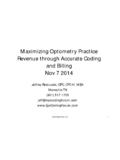Transcription of MAXIMIZING PRODUCTIVITY IN PRODUCT …
1 Compliments of: Stage-Gate International and PRODUCT Development Institute Inc. This article was published by Research-Technology Management Volume 51, No. 2, March-April 2008 For information call +1-905-304-8797 MAXIMIZING PRODUCTIVITY IN PRODUCT innovation Dr. Robert G. Cooper and Dr. Scott J. Edgett PRODUCT innovation Best Practices Series Reference Paper # 28 PRODUCT Development Institute Inc. 2000-2014 PRODUCT Development Institute Inc. and Stage-Gate ar e registered trademarks. Logo for PRODUCT Development Institute Inc. used unde r licen se by Stage-Gate International. Logo for Stage-Gate used under license where appropriate. 2 MAXIMIZING PRODUCTIVITY IN PRODUCT innovation OVERVIEW: Recent evidence suggests that PRODUCTIVITY in new PRODUCT development (NPD) is declining; that is, we are seeing less output (measured in terms of impact on the business) for the same relative spending level.
2 This article outlines seven practices or principles which, according to studies of NPD practices and performance, will increase NPD PRODUCTIVITY after they are embraced. These principles include familiar concepts such as building in the voice of the customer, front-end load-ing projects, and taking a more holistic approach to PRODUCT innovation . However, while they are familiar, it is surprising how many firms have yet to embrace them. Other, less familiar, principles include: relying on spiral rather than linear development; building in metrics, team accountability and continuous improve-ment; and portfolio management techniques to yield higher value projects. Finally, a number of best performers are redesigning their idea-to-launch processes, moving to the next-generation Stage-Gate system; they employ methods borrowed from lean manufacturing to remove waste from their development processes, and they also make their processes scalable, flexible, adaptable, and more open to the external environment.
3 These pages contain copyright information of PRODUCT Development Institute and membercompany Stage-Gate International, including logos, tag lines, trademarks and the content of this article. Reproducing in whole or any part of this document is strictly forbidden without written permission from PRODUCT Development Inc. or Stage-Gate International. KEY CONCEPTS: NPD PRODUCTIVITY , lean PRODUCT development, Stage-Gate , portfolio management. The concept of PRODUCTIVITY is simple: it is output over input, or, "the most bang for the buck." More specifi-cally, in the field of new PRODUCT development (NPD), PRODUCTIVITY is defined as output (measured as new PRODUCT sales or profits) divided by input (measured as R&D or NPD costs and time). For example: Because the concept of NPD PRODUCTIVITY is relatively new, there are few hard numbers on results achieved in industry.
4 Indeed, a best-practices American Pro-ductivity and Quality Center (APQC) study reveals that almost no companies measure or report their NPD or R&D PRODUCTIVITY as a business metric (7). There is strong evidence that NPD PRODUCTIVITY is heading in the wrong direction, however. In the United States, the most recent PRODUCT Development & Management Association (PDMA) best-practices study reveals that sales from new products are off in a period when R&D spending has remained constant: New PRODUCT sales fell from percent of total company sales in the mid-1990s to percent by 2004 (2). At the same time, R&D spending in the remains unchanged: for example, percent of GNP in 1985 versus percent in 2004. That is a 14 percent drop in output per spending in less than a decade quite a dramatic downward shift in NPD PRODUCTIVITY .
5 If it's time to take a hard look at the methods and systems you rely on to conceive,develop and launch new products, then these seven principles are a good place to start. Dr. Robert G. Cooper and Dr. Scott J. Edgett 2000-2014 PRODUCT Development Institute Inc. PRODUCT Development Institute Inc. and Stage-Gate International are registered trademarks. 3 MAXIMIZING PRODUCTIVITY IN PRODUCT innovation Scott Edgett is CEO and co-founder of the PRODUCT Develop-ment Institute and Faculty Scholar with ISBM at Penn State University's Smeal College of Business Administration. A spe-cialist in new PRODUCT development and portfolio management, he received his in marketing from Bradford University. He has consulted and written extensively in the field, with over 60 published articles and five books. His latest book (co-authored with Robert Cooper) is Generating Breakthrough New PRODUCT Ideas (PDI, Toronto, 2007).
6 One startling conclusion is how much PRODUCTIVITY varies by industry, from a high of 14:1 in consumer goods to a low of about 2:1 in the pharmaceutical in-dustry. A second revelation is how low the productiv-ity numbers are; note that output was measured by sales over five years. When one compares the PRODUCTIVITY of the most pro-ductive companies versus the least productive, the results are even more provocative (Figure 1). There are huge differences in PRODUCTIVITY between the best and worst performers on average, almost a 1,200 percent difference! And in some industries, such as pharmaceutical, the differences are even greater. For example, the top 25 percent pharmaceutical firms are 31 times more productive in NPD than the bottom 25 percent. This significant decrease in just a handful of years is cause for concern (3).
7 What's going on? There's no evidence that people are doing a worse job today deficient design and development work, poor market studies, or bad launches. Indeed, a comparison of the quality-of-execution of key activities between 1985 and today from initial screening through to market launch reveals no change in quality-of-execution ratings (4). On the other hand, PRODUCT developers have not improved quality-of-execution at a time when most pundits believe they should have, so that is a second cause for concern. The one factor that does show a dramatic change, however, and that explains the decrease in profitabil-ity, impact and PRODUCTIVITY , is the balance in the port-folio of projects undertaken today versus in 1990. Simply stated, businesses today are preoccupied with minor modifications, PRODUCT tweaks, and minor re-sponses to salespeople's requests, while true PRODUCT development has taken a back seat (3).
8 Major Gaps in NPD Productivities One recent Arthur D. Little study provides insights into PRODUCTIVITY by industry (5). The study looked at output measured by five-year sales from new prod-ucts as a percentage of company sales and input, measured by R&D spending, also as a percentage of company sales (see Figure 1). Robert Cooper is president of the PRODUCT Development Insti-tute and professor of marketing at McMaster University, Hamil-ton, Ontario, Canada, as well as Crawford Fellow of the Prod-uct Development and Management Association, and ISBM Dis-tinguished Research Fellow at Penn State University's Smeal College of Business Administration. He has won two Maurice Holland awards for the best paper published in Research-Technology Management ("New Products: What Distinguishes the Winners, " in 1990, and "Debunking the Myths of New PRODUCT Development, " in 1994) and has published over 100 articles and six books.
9 A thought leader in the field of PRODUCT innovation management and developer of the Stage-Gate new PRODUCT process, he received his in business administra-tion from the University of Western Ontario. There are huge differences in PRODUCTIVITY between the best and worst performers. Dr. Robert G. Cooper and Dr. Scott J. Edgett 2000-2014 PRODUCT Development Institute Inc. PRODUCT Development Institute Inc. and Stage-Gate International are registered trademarks. 4 MAXIMIZING PRODUCTIVITY IN PRODUCT innovation These huge PRODUCTIVITY differences between top and poor performers lead to the obvious question: why? What is it that these high- PRODUCTIVITY businesses do so differently? And can your business learn from them? Data from a number of best practices studies helps us gain insights into what the secrets to high PRODUCTIVITY are what the best performing companies do so differently (see "Sources of the Data," below).
10 The Seven Principles These principles of lean, rapid and profitable NPD, with the goal of improving PRODUCTIVITY , have been developed from a long line of research investigations, culminating in the most recent APQC study (1,6). Each of the seven principles is very much fact-based; that is, research investigations reveal that businesses or project teams that employ each principle achieve superior performance results. For example, in the sections to follow, you will see bar chart results from the APQC study. What these bar chart results show is that best-performing businesses do employ each of these seven principles to a far greater extent than the rest of the businesses, and that poor performers in particular tend to ignore these prin-ciples. Note that the research results have been widely published in refereed journals, including RTM, lend-ing credibility and authenticity to what is presented; this is not simply a treatise based on a handful of an-ecdotes, case studies or home-grown research.










